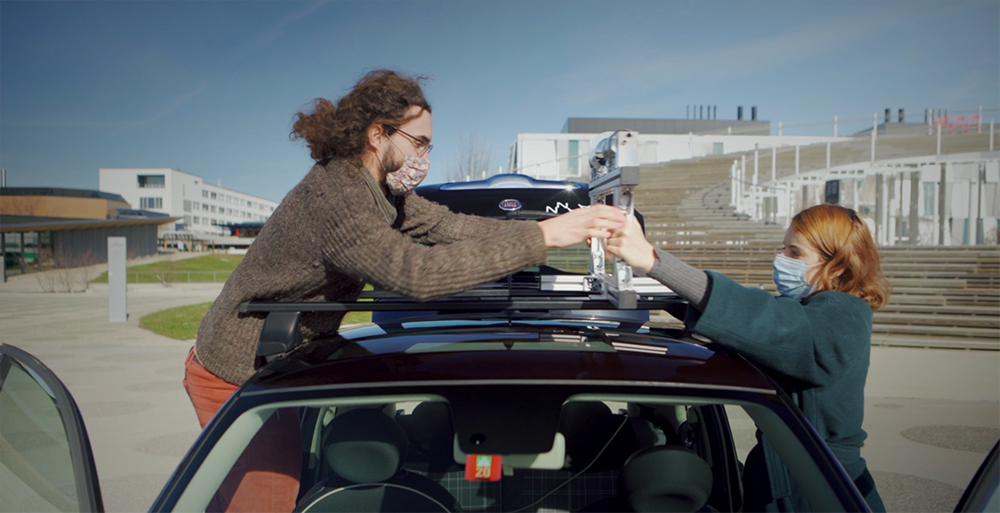"It's amazing to drive through a city and end up with a 3D model!”

© DHLAB / EPFL
Albane Descombes, a young member of EPFL’s Digital Humanities Laboratory (DHLAB) had a wide-ranging and unconventional research experience helping with the final implementation of a four-year project in urban digitization, ScanVan.
Albane began her academic career at EPFL in the bachelor of civil engineering before joining the Master in Digital Humanities in 2017 as part of the very first cohort for this new program. She remembers, “I thought it was perfect for me because I really love programming, which I discovered at EPFL, and I also liked the humanities part, as I am fond of paintings and art history.” After joining the DHLAB, she became a specialist of 3D modelling and photogrammetry through a project in collaboration with the Louvre museum. Her general responsibilities included scoping out the different sites to be scanned, planning the route, completing the scans, and adapting existing algorithms to process the data. She explains, “in the ScanVan project I was doing all of this, but the main thing that changed from my previous experience was that for the first time we were doing it with a car. By car we go faster and take many more images, but we are more constrained by the street life and weather.” The ScanVan is topped with an omnidirectional camera that produces spherical images at regular intervals as the vehicle moves through the urban environment.

Albane places the camera on the roof of the car with her colleague Didier Dupertuis (who is also the web developer for the project), before going for a round of digitization.
Albane’s first task upon joining the ScanVan project in early 2020 was to buy a car. She visited auto dealers around Lausanne and settled on the Fiat 500, for its small size and maneuverability. The car was then outfitted to become the ScanVan in the HES-SO Valais/Wallis Institute of Systems Engineering. Along with other members of the project from the DHLAB, Albane traveled to Sion where a team led by Pierre-André Mudry installed the omni-directional camera which they had constructed for the project.
After the installation was complete, the final task was to produce a monolithic, geolocalized 3D model of the city of Sion in order to test the ScanVan. Albane prepared by developing a program capable of planning the ScanVan’s path through Sion. This was a complex task as each street (including one-way roads) is, ideally,visited only once by the ScanVan in closed-loop paths. Albane and a team of colleagues then took turns driving the ScanVan around Sion until they had completed the full route. She reflects:
I liked both going on site and also working on the technical part…It was really fun to drive all day taking pictures with my colleague, but I would not want to do it every day. One day is enough. At the same time,staying at the lab in front of the screen all day can be rewarding yet quite alienating sometimes. So it is a relief to switch between both aspects…I also like doing both because it’s amazing to drive through a city and end up with a 3D model!
After completing the scan of Sion, Albane helped ensure that the data was compliant with privacy regulations. She and an EPFL colleague collaborated with Zurich’s Center for Information Technology, Society, and Law where two law students explained what privacy requirements would have to be met before publishing the ScanVan data. Under the leadership of Florent Thouvenin, the Zurich team recommended a “privacy by design” strategy, which uses automatic algorithmic processes to blur identifiable information (such as faces or vehicle license plates). Back at the DHLAB, Albane was responsible for the practical implementation of privacy by design, “which meant training an image segmentation model to recognize all the faces and car plates, and then running the model over all the images to blur the private content.”
Reflecting upon how ScanVan fits into her long-term professional and intellectual trajectory, Albane says, “I am quite specialized in photogrammetry now, which is not a common job but I really love it and hope that I will continue working in this field.” She notes that the pandemic conditions have highlighted the rich future potential of photogrammetry and 3D modeling for video games, virtual reality and 3D streaming, “now that everyone is at home but wants to discover inaccessible parts of the world.” For the moment, Albane is taking the opportunity to explore this emerging field through her work in the DHLAB before deciding which path she will pursue next.